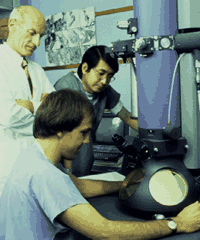| NADC History |

|
History of NADC:
In 1905, the United States Department of Agriculture responded to the hog cholera problem in the United States by constructing the Hog Cholera Research Station on 35 acres of land in Ames, Iowa. Hog cholera was a prevalent disease of swine that resulted in losses in the U.S. estimated at $6,000,000 in 1917. The Ames station conducted research and diagnostic services on hog cholera until the National Animal Disease Laboratory (NADL) opened in 1961.
The NADL was officially established as a facility of the Agricultural Research Service (ARS) on July 27, 1956, when President Dwight D. Eisenhower signed the appropriation bill containing the $16,250,000 that was needed to construct and equip the laboratory. Built near the original site of the Hog Cholera Research Station on 318 acres of land donated by the State of Iowa, the lab became operational in 1961. Staff and animals from Beltsville, Maryland relocated to the Ames lab. Diseases such as brucellosis, viral diarrhea, leptospirosis, fowl cholera, salmonellosis, and foot rot were studied. Hog cholera research also continued. During the 1960's and 70's, hog cholera was estimated to be responsible for losses up to $100,000,000 per year. It was during this time that NADL scientists developed a successful diagnostic test that was instrumental in eradicating this disease from the U. S. by 1978. That test is still used in the U.S. and in other parts of the world today.
The NADL was renamed The National Animal Disease Center (NADC) in 1973. The focus of the Center was, and continues to be, to conduct basic and applied research on the diseases of livestock and poultry, which are of major economic importance to U.S. agriculture, and to apply the results to animal disease prevention and control programs. Today the Center has established itself as a leader in animal health research and remains one of the world's largest animal health facilities with the equivalent of 5 city blocks under roof. Research scientists and other staff specialists continue to focus on providing solutions to the livestock industry and the public.

Aerial view of the Hog Cholera Research Station

Preparing to vaccinate a pig against hog cholera

Feeding hogs at the Hog Cholera Research Station

Early laboratory scene at the Hog Cholera Research Station

Model illustrating the proposed facility

Construction crews work on the new facility

National Animal Disease Laboratory
is dedicated to President Dwight D. Eisenhower

Photograph from a newspaper
article describing the new
National Animal Disease Laboratory

Sows and piglets in a barn at the
National Animal Disease Laboratory

A special herd of breeding cattle, which had
been maintained Brucella-free for more than
20 years, was transported from
Beltsville, Maryland to the
National Animal Disease Laboratory
in 1961 by special train.

Sheep outside an NADC barn in 1965.
In the "early" days of NADC, sheep research
focused on ecthyma and foot rot.

Chickens in an NADC barn in 1965.
Studies were conducted on fowl cholera,
infectious bronchitis, and salmonellosis.

Cattle outside an NADC barn in 1965.
During this time such diseases as brucellosis,
foot rot, viral diarrhea, leptospirosis, shipping
fever and paratuberculosis were studied.

Dr. William Mengeling and Dr. Eugene Pirtle
play key roles in the eradication of
Hog Cholera in the late 1960's.

Scientists reviewing sequence
data in the late 1980's.

Scientists gathered around an
electron microscope in the late 1980's.

Cows grazing on NADC grounds
